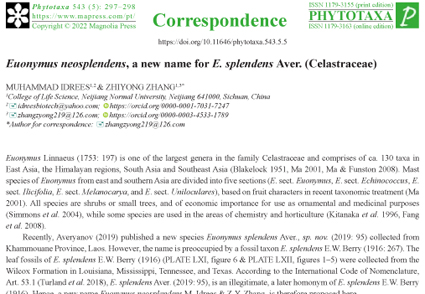Abstract
N/A
References
Averyanov, L.V. (2019) Rosaceae. In: Averyanov, L.V., Nguyen, K.S., Maisak, T. (Eds.) Plant diversity, flora and vegetation of Hin Nam No National Protected Area: Plant Communities and Plant Species Diversity of Hin Nam No National Protected Area. Lap Lambert Academic Publishing, pp. 1–431.
Berry, E.W. (1916) The Lower Eocene Floras of Southwestern North America. U.S. Geological Survey, Professional Paper 91. Washington, D.C., 591 pp. https://doi.org/10.5962/bhl.title.7602
Blakelock, R.A. (1951) A synopsis of the genus Euonymus L. Kew Bulletin 6: 210–290. http://dx.doi.org/10.2307/4120601
Fang, X.-K., Gao, J. & Zhu, D.-N. (2008) Kaempferol and quercetin isolated from Euonymus alatus improve glucose uptake of 3T3-L1 cells without adipogenesis activity. Life Sciences 82: 615–622. https://doi.org/10.1016/j.lfs.2007.12.021
Kitanaka, S., Takido, M., Mizoue, K. & Nakaike, S. (1996) Cytotoxic cardenolides from woods of Euonymus alata. Chemical & Pharmaceutical Bulletin 44: 615–617. https://doi.org/10.1248/cpb.44.615
Linnaeus, C. (1753) Species plantarum 1. Laurentii Salvii, Stockholm, 572 pp. https://doi.org/10.5962/bhl.title.669
Ma, J.S. (2001) A revision of Euonymus (Celastraceae). Thaiszia 11: 1–264.
Ma, J.S. & Funston, A.M. (2008) Euonymus. In: Wu, Z.Y., Raven, P.H. & Hong, D.Y. (eds.) Flora of China 11. Science Press, Beijing & Missouri Botanical Garden Press, St. Louis. pp. 440–463. http://dx.doi.org/10.3120/0024-9637-55.4.296
Newman, M., Ketphanh, S., Svengsuksa, B., Thomas, P., Sengdala, K., Lamxay, V. & Armstrong, K. (2007) A checklist of the Vascular Plants of Lao PDR. Royal Botanic Garden Edinburgh, 394 pp.
Turland, N.J., Wiersema, J.H., Barrie, F.R., Greuter, W., Hawksworth, D.L., Herendeen, P.S., Knapp, S., Kusber, W.-H., Li, D.-Z., Marhold, K., May, T.W., McNeill, J., Monro, A.M., Prado, J. Price, M.J. & Smith, G.F. (eds.) (2018) International Code of Nomenclature for algae, fungi, and plants (Shenzhen Code) adopted by the Nineteenth International Botanical Congress Shenzhen, China, July 2017. Regnum Vegetabile 159. Koeltz Botanical Books, Glashütten, 254 pp. https://doi.org/10.12705/Code.2018
Simmons, M.P. (2004) Celastraceae. Flowering plants. Dicotyledons. In: Kubitzki, K. (Eds.) The Families and Genera of Vascular Plants 6. Berlin/Heidelberg/New York. pp. 29–64. https://doi.org/10.1007/978-3-662-07257-8
Berry, E.W. (1916) The Lower Eocene Floras of Southwestern North America. U.S. Geological Survey, Professional Paper 91. Washington, D.C., 591 pp. https://doi.org/10.5962/bhl.title.7602
Blakelock, R.A. (1951) A synopsis of the genus Euonymus L. Kew Bulletin 6: 210–290. http://dx.doi.org/10.2307/4120601
Fang, X.-K., Gao, J. & Zhu, D.-N. (2008) Kaempferol and quercetin isolated from Euonymus alatus improve glucose uptake of 3T3-L1 cells without adipogenesis activity. Life Sciences 82: 615–622. https://doi.org/10.1016/j.lfs.2007.12.021
Kitanaka, S., Takido, M., Mizoue, K. & Nakaike, S. (1996) Cytotoxic cardenolides from woods of Euonymus alata. Chemical & Pharmaceutical Bulletin 44: 615–617. https://doi.org/10.1248/cpb.44.615
Linnaeus, C. (1753) Species plantarum 1. Laurentii Salvii, Stockholm, 572 pp. https://doi.org/10.5962/bhl.title.669
Ma, J.S. (2001) A revision of Euonymus (Celastraceae). Thaiszia 11: 1–264.
Ma, J.S. & Funston, A.M. (2008) Euonymus. In: Wu, Z.Y., Raven, P.H. & Hong, D.Y. (eds.) Flora of China 11. Science Press, Beijing & Missouri Botanical Garden Press, St. Louis. pp. 440–463. http://dx.doi.org/10.3120/0024-9637-55.4.296
Newman, M., Ketphanh, S., Svengsuksa, B., Thomas, P., Sengdala, K., Lamxay, V. & Armstrong, K. (2007) A checklist of the Vascular Plants of Lao PDR. Royal Botanic Garden Edinburgh, 394 pp.
Turland, N.J., Wiersema, J.H., Barrie, F.R., Greuter, W., Hawksworth, D.L., Herendeen, P.S., Knapp, S., Kusber, W.-H., Li, D.-Z., Marhold, K., May, T.W., McNeill, J., Monro, A.M., Prado, J. Price, M.J. & Smith, G.F. (eds.) (2018) International Code of Nomenclature for algae, fungi, and plants (Shenzhen Code) adopted by the Nineteenth International Botanical Congress Shenzhen, China, July 2017. Regnum Vegetabile 159. Koeltz Botanical Books, Glashütten, 254 pp. https://doi.org/10.12705/Code.2018
Simmons, M.P. (2004) Celastraceae. Flowering plants. Dicotyledons. In: Kubitzki, K. (Eds.) The Families and Genera of Vascular Plants 6. Berlin/Heidelberg/New York. pp. 29–64. https://doi.org/10.1007/978-3-662-07257-8


